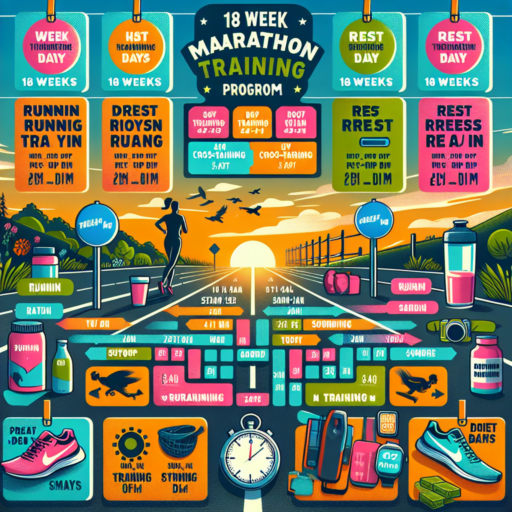How to create your own marathon training plan?
Creating your own marathon training plan is a pivotal step in turning your marathon dreams into reality. The process requires a blend of personalizing your goals, understanding your current physical fitness level, and structuring your training to progressively increase endurance and speed. By focusing on these core areas, you can develop a plan that not only prepares you for the marathon but also aligns with your lifestyle and fitness aspirations.
Firstly, it’s crucial to establish specific goals for your marathon, whether it’s finishing within a particular time frame or simply crossing the finish line. These goals will dictate the intensity and volume of your training. Understanding your baseline through fitness assessments such as a time trial can provide valuable insights into your current state and guide the customization of your training plan. This step cannot be overstated, as it ensures the plan is challenging yet achievable, setting you up for success without risking overtraining or injury.
Incorporating varied training elements is the next step. A mix of long runs, speed work (like intervals and tempo runs), and recovery days creates a well-rounded plan that improves endurance, speed, and overall cardiovascular fitness. It is also important to gradually increase your mileage, adhering to the 10% rule to prevent injuries. Each aspect of your plan should be reflective of your goals and physical conditioning, ensuring a balanced approach to training that fosters continuous improvement and keeps the risk of burnout at bay.
No se han encontrado productos.
How do I find the best marathon training plan?
Finding the best marathon training plan can feel like searching for a needle in a haystack given the plethora of advice available online. However, by focusing on the criteria that matter most to your fitness level, running experience, and personal goals, you can narrow down the field significantly.
Firstly, assess your current fitness level and running experience. If you’re new to running, look for a beginner-friendly plan that emphasizes gradual mileage increase to prevent injuries. For more experienced runners, a plan that introduces speed work, hill sessions, and longer runs might be more appropriate. **Identify your baseline** and look for plans that challenge you without pushing you into the injury zone.
Next, consider the time commitment you can realistically make. Marathon training plans typically range from 12 to 20 weeks and require a commitment of four to six days of training per week. Evaluate your schedule to determine how much time you can dedicate to training. Plans that integrate with your lifestyle are more sustainable and less likely to lead to burnout or overtraining.
Lastly, it’s essential to think about your personal goals. Are you aiming to finish your first marathon, or are you looking to set a new personal best? Your objective can significantly influence the intensity and volume of the training plan. Plans geared towards beginners usually focus on building endurance to comfortably complete the marathon distance, while advanced plans may incorporate more rigorous speed and tempo workouts aimed at improving race times.
Remember, the best marathon training plan is one that aligns with your current fitness level, fits into your lifestyle, and supports your running goals. By taking these factors into consideration, you can select a plan that not only prepares you for race day but also keeps you motivated and injury-free throughout your training journey.
What is the Jack Daniels Elite plan?
The Jack Daniels Elite plan is a premium offering designed for the most discerning fans of Jack Daniel’s, a renowned whiskey brand cherished worldwide. This plan is not merely about enjoying high-quality whiskey; it’s an exclusive membership that opens up a world of privileges, events, and bespoke services tailored to elevate the whiskey-consuming experience to unparalleled heights. From limited-edition bottles to private tours of the distillery, the Elite plan caters to every aspect of luxury whiskey enjoyment.
Members of the Jack Daniels Elite plan gain access to a plethora of benefits, chief among them being the opportunity to taste and purchase rare and limited Jack Daniel’s releases before they are available to the public. This priority access ensures that collectors and connoisseurs can add the most sought-after bottles to their collections. In addition, Elite plan members are often invited to exclusive whiskey-tasting events, where they can savor Jack Daniel’s expressions under the guidance of experienced distillers and blenders.
The Elite plan also emphasizes personalized experiences, offering members the chance to partake in bespoke tours at the Jack Daniel’s Distillery in Lynchburg, Tennessee. These tours are designed to offer a deep dive into the nuanced world of whiskey making, from the intricacies of the mashing process to the secrets behind the brand’s signature charcoal mellowing. Moreover, Elite plan members can enjoy personalized engraving services on bottles, making them perfect gifts or unique additions to a personal collection.
How do I train myself for a marathon?
Training for a marathon is a significant commitment, but with the right strategy, it can be an incredibly rewarding experience. To ensure you’re on the path to success, follow these key steps and considerations.
Build a Solid Base
Before diving into marathon-specific training, it’s crucial to have a solid running base. This means consistently running for several months, ideally for about 20-30 miles a week before embarking on a marathon training plan. Building this foundation gradually increases your endurance and reduces the risk of injury.
Create a Structured Training Plan
Once you have a strong base, the next step is to find or create a structured training plan tailored to your current level and goals. A typical plan should span 16 to 20 weeks and incorporate various elements:
- Variety of runs (long runs, speed work, easy days, and rest days)
- Gradually increasing long run distances, with a peak long run of 18-22 miles
- Cross-training activities to enhance fitness and prevent burnout
This kind of structured approach helps build your stamina, speed, and confidence, preparing you for the marathon distance.
Listen to Your Body
It’s essential to pay attention to your body’s signals throughout your training. Rest and recovery days are just as important as your running days. If you feel overly fatigued, sore, or face any signs of potential injury, it’s crucial to take adequate rest or seek medical advice. Pushing through pain can lead to serious injuries, derailing your marathon plans.
Implementing these key strategies will put you on the right track to successfully training yourself for a marathon. Remember, consistency and patience are paramount. With dedication and the right preparation, reaching that finish line is an achievable goal.




